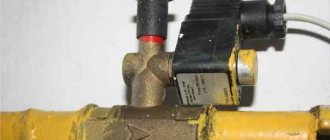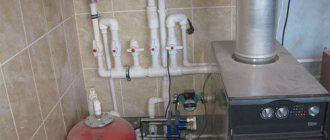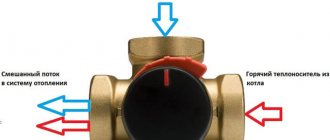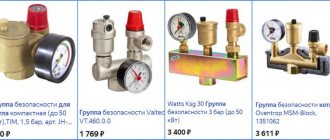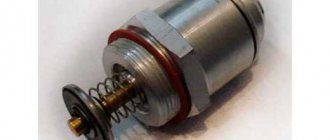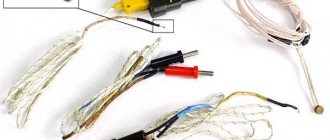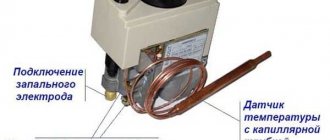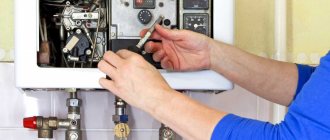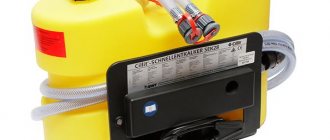The situation is as follows. The boiler only works when the button is pressed. In many cases, everyone immediately thinks that the solenoid valve is faulty. Or worse. It happens that it is not immediately clear what is going on, and there is a great desire to immediately change the entire automation unit as a whole. The most annoying thing is that the main cause of the malfunction may not be affected or eliminated. And after replacing the automation unit, everything will remain as it was. Therefore, please, until you figure out what’s going on, until you see real evidence, do not make hasty decisions regarding replacing the block .
The situation in this case is that the boiler works “directly”, so to speak, bypassing all protections. This is unacceptable, although it is very common in everyday practice. Some people don’t even suspect that gas enters the boiler bypassing the protection against extinguishing the igniter, so to speak, directly into the boiler.
When the solenoid valve button does not lock, there are only three faults.
1. Thermocouple malfunction. The thermocouple is either burnt out or there is poor contact between the thermocouple and the solenoid valve.
First, let's check the thermocouple. Unscrew the thermocouple connection nut. We leave its tip in the working igniter (the boiler is working?!) and take the tester. One probe is on the thermocouple body, the other is on the contact at the end of the thermocouple.
When heated, the thermocouple generates an EMF, which should keep the valve button pressed. If the EMF is less than 20 mV, then the thermocouple definitely needs to be replaced. And you need “Instructions for replacing the thermocouple”.
2. Solenoid valve malfunction. Electromagnetic valves behave differently, but for the most part they are reliable, low-current and rather primitive devices, inside of which there is an ordinary winding. There is current, the magnet magnetizes, there is no current and there is no magnet. Boxes usually become obsolete after years have passed. There are also cases when they try to tighten the nut of a thermocouple or thermoplate as tightly as possible (and here you just need a regular electrical contact). They pull so that they tear off the winding wires inside the box from the outgoing contacts. You can try measuring the resistance of the solenoid valve, but usually no one does this. The solenoid valve is usually the last to be changed in the chain of spare parts listed here . Or it simply changes on its own when the boiler has been operating for more than 10-15 years. Or, if the boiler is located far away geographically, we take the valve with us in order to eliminate the problem in any way and for sure . If you decide to replace the Solenoid Valve, you will definitely need the “Instructions for replacing the Solenoid Valve” to carry out this process.
3. Malfunctions related to the operation of the thermal plate (poor traction)
The problems associated with the operation of this device have long been known. The very place where the thermal plate is located is exposed to both air and condensation. Ordinary rust, oxidation, poor contact, souring sometimes even causes hatred towards this device. The plant even produced a special control nut to detect problems associated with the operation of the thermal plate. By throwing the control nut onto the right contact of the Solenoid valve, you immediately bypass the thermal plate and understand whether it is it or not. The fact is that while the right contact of the electromagnetic valve is open (and should be normally closed), we will not understand at all what is wrong with the boiler. If there is no nut at hand, we close the right contact of the valve to the body, for example, using foil. If everything works right away, we deal with the thermal plate: clean it, adjust it, etc. In order to get serious about the thermoplate, it would be nice to get “Complete information on the operation of the thermoplate (poor traction).”
Here were presented all three of the most frequently repeated faults that “prevent the solenoid valve button from remaining in the pressed position.”
It is difficult to say right away what exactly is faulty.
1. All cases come down to checking the contact of the thermocouple with the solenoid valve and the contact of the thermoplate, which should be normally closed .
2. If the contact is tight, then check the thermocouple . If the thermocouple produces less than 16 mV, we change the thermocouple.
3. If it does not work with a working thermocouple, put a control nut on the second contact of the valve (or wind foil to close the contact to the body) to eliminate the electromagnet-thermoplate circuit.
5. If it still doesn’t work, change the solenoid valve.
6. If it doesn’t work when everything has been changed, we check it again in a circle.
7. Take your time. All this rubbish comes only from these three elements or from their incorrect interaction. We don't give up!
Thermocouple for a gas boiler: principle of operation, characteristics, troubleshooting
The use of gas for heating a private house or cottage is very convenient and cost-effective.
However, this type of fuel poses a serious threat. If for any reason the burner suddenly goes out and the gas supply is not turned off in time, a leak will form and this can result in serious trouble and endanger the lives of people in the room. In order to immediately shut off the gas if the flame suddenly goes out, a thermocouple is used for a gas boiler. In this article we will talk about what a thermocouple is, why it is needed and how it works, we will consider the main types and most common faults associated with these devices, as well as methods for eliminating them.
Device, principle of operation and main types
A thermocouple is a classic thermoelectric converter that is used to measure temperature in various fields of industry, science, medicine, as well as in automatic control and monitoring systems for gas boilers, stoves and water heaters.
It is designed very simply and can easily be made independently. Two conductors made of different materials are connected into a ring. One of the connection points is placed in the measurement area, and the second is connected to the measuring instrument or converter device.
Photo 1: Thermocouple for gas control device
The operating principle of a thermocouple is based on the thermoelectric effect, or as it is also called the Seebeck effect. It lies in the fact that voltage appears at the junction of two conductors made of different metals connected in a ring. If the temperature of the adhesion sites is the same, the potential difference is zero. But as soon as one of the junctions is placed in an area with a higher or lower temperature, a voltage appears that is different from zero and proportional to the temperature difference. The proportionality coefficient is different for different metals and is called the thermo-EMF coefficient.
Photo 2: Design and principle of operation of the thermocouple
The main materials for the manufacture of thermocouples are noble and base metals. Most of their alloys have rather exotic names, which are very popular among the compilers of various crosswords and scanwords. Depending on what metal pairs are used in manufacturing, thermocouples are divided into several types. Below is a table with their main types, designations and characteristics:
In automatic systems for geysers, stoves and boilers, thermocouples TCA made of chromel-alumel (type K), TCA from chromel-copel (type L), TLC made of iron and constantan (type J) are usually used. Sensors made of noble metal alloy are designed for high temperatures and are mainly used in foundries and other heavy industries.
Photo 3: Sakhalin gas burner for heating boilers and furnaces
Some models operating on solid fuel, for example, such as the solid fuel heating boiler “Lemax” Forward, can be equipped with gas burners, which use thermocouples to protect against gas leaks.
Return to contents
Thermocouple in the gas control system (gas control)
If you decide to install a solid fuel boiler in your country house. you don't have to worry about what will happen if the fire suddenly goes out. However, when you use gas equipment, you need non-volatile automation that can shut off the gas supply as quickly as possible if the burner suddenly goes out. For these purposes, modern gas boilers are equipped with a gas control system. How does it work?
The system consists of two main parts: a solenoid valve and a thermocouple. One end of the sensor is placed directly in the burner flame, and the second is connected to an electric valve, which consists of a core with a winding, a cap, a return spring, an armature and a rubber band that shuts off the gas supply.
Photo 4: Non-volatile gas control system for stoves and boilers
The gas control works quite simply. By pressing the gas button, you push the rod inside the coil, charging the spring. According to the instructions for igniting a gas boiler, the supply valve must be held pressed for about several tens of seconds. This time is necessary for the thermocouple to warm up and sufficient voltage to appear at its ends to hold the valve inside the coil.
At the moment when the burner goes out, the thermocouple begins to cool, the voltage at the ends of the thermocouple decreases and at some point, the return force of the spring outweighs the electromagnetic force holding the rod inside and returns the valve to its original position, cutting off the gas supply. This process usually takes several tens of seconds.
One of the features of gas control is that it is completely electrically independent. In large heating complexes, like the domestic Svetlobor pellet boiler. When the power supply is turned off, the entire control system ceases to function. The thermocouple gas control system is completely electrically independent and can operate reliably without the need to connect to an electrical outlet.
Return to contents
Connection, testing and troubleshooting
One of the common malfunctions of gas boilers is as follows: you press the gas supply button, light the igniter, hold it for the required 30 seconds, release it and the burner immediately goes out. One of the reasons that can lead to this result is a faulty thermocouple or its poor contact with the solenoid valve.
Photo 5: Connecting and checking the thermocouple on the measuring device
You can fix this problem yourself without resorting to the services of a specialist. To do this you need to follow these steps:
- Using a wrench, unscrew the clamping nut that holds the thermocouple in contact with the solenoid valve and remove its end.
- We inspect the connector for the presence of various oxides and contaminants. If necessary, use fine sandpaper to carefully clean the contact area.
- Next, you should check the thermocouple with a multimeter. To do this, we connect one end to the measuring device, and heat the other with a manual gas burner. The voltage at the ends of a working thermocouple should be about 50 mV.
- If all indicators are normal, you should put everything back together and try to start the boiler.
If the problem remains, most likely the solenoid valve itself is faulty or the contact between it and the thermocouple is still poor. If the valve is in good condition, you should re-clean the connection and try to find a position of the clamping nut at which good contact is achieved.
Useful:
A compensation wire is usually used to connect thermocouples to measuring instruments. In this cable, the cores are made of the same material as the sensor itself. This can significantly reduce measurement error.
If the thermocouple fails, you need to buy a new one. There are many different manufacturers producing these sensors on the Russian market: Arbat, AKGV, AOGV (Zhukovsky plant), Honeywell. Prices for different types range from 600 to 2000 rubles.
For more information on how to repair a thermocouple in a gas boiler yourself at home, see the following video:
Return to contents Conclusion
Thermocouples are actively used not only in the automation of gas stoves, boilers and water heaters. Based on them, many different thermostats and thermometers have been produced, both for household and industrial purposes. Many craftsmen, based on a thermoelectric converter, make their own chargers and mini power stations that can charge phones and other low-power devices directly from a fire or other open flame. We hope you liked our story, and you learned a little more about the nuances of the operation of such familiar household appliances.
How to test a thermocouple using a multimeter
In private houses and apartments where gas is installed, in addition to kitchen stoves, gas boilers are often found to provide hot water supply and heating. Most heating and household gas appliances have a thermocouple in their design, which protects the device from overheating, which in turn ensures the safe operation of such equipment.
What is a thermocouple?
The thermocouple design includes two dissimilar conductors that are in direct contact with each other at one or more points (in rare cases, they are connected by compensation wires). When a temperature change occurs in the sensor area, voltage is created inside the device.
This ensures temperature control and overheating protection. Thermocouples can also be used to convert thermal energy into other types of energy, including electric current.
The main characteristics of a thermoelectric converter directly depend on the material from which they are made. Any temperature sensor made from two different metals will produce an electrical potential when exposed to temperature, but the response temperature will be different for each combination of metals. Due to this, thermocouples differ in their level of temperature control.
There are many types of thermostats, but their resistance to corrosion will be important. In those models of thermoelectric converters where the temperature sensor is located at a sufficient distance from the measuring device, expansion wiring is used in the design to connect them, thereby reducing the cost of the device.
Most thermocouples are standardized during production to a temperature standard of 0 degrees Celsius. Most manufacturers use electronic cold solder compensation technologies, which correct temperature differences at the device terminals.
Also, due to special electrical engineering, it is possible to minimize the deviation of other characteristics, which makes thermocouples more accurate and measurements as close to reality as possible.
Thermoelectric converters have become widespread in both household and industrial heating equipment. These simple yet useful devices can be found in the design of geyser, kitchen stove, industrial furnace, exhaust gas turbine, diesel engine, etc.
Gas boiler valve repair: how to repair the unit by correcting characteristic malfunctions
Gas boilers are reliable equipment that supply our country houses and some city apartments with heat and hot water. Unfortunately, they cannot work completely without breakdowns. And violations often include valves - devices for protecting and supplying fuel to units.
We will tell you how and what kind of gas boiler valve repairs you can do yourself. We will analyze in detail the situations that signal the occurrence of related disruptions in work. We’ll tell you whether it’s worth making your own efforts or whether it’s better to turn to gas workers.
In our article you will find step-by-step guides to restoring the performance of gas boilers by repairing or replacing the gas, safety and three-way valves.
The wick does not light
If the column lights up, but very poorly, then there may be several reasons. Let's look at each of them:
- If the piezoelectric element does not work, then problems with the igniter may occur in the Astra and Zerten models. The wick should always be lit, and it is triggered when the tap is opened or when the corresponding button is pressed. If the element does not work, the wick does not burn, then the column jets may be clogged. To do this, disassemble the device, remove the metal protection or casing and clear the clogged nozzle. It is better to do this with thin wire. Usually, after cleaning the nozzle, the column works normally. This is one of the reasons why the Astra gas water heater and other similar devices do not light up.
- Another case is automatic speakers that take a long time to light up. The automatic ignition system of the column runs on batteries. When the tap opens, the device is triggered and a powerful spark is formed, which ignites the column burner. If there is no spark, then you should try replacing the batteries, or better yet install batteries.
- The generator of the hydrodynamic system may also fail. The generator rotates when water passes through it. When the unit rotates, it generates a current, from which a spark is then formed. If this is precisely the reason why the gas water heater does not light up, then it is better to entrust the repair to professionals.
Types of valves in a gas boiler
The normal operation of gas equipment intended for heating sanitary water and preparing coolant is ensured by a wide range of systems, parts, devices, each of which clearly performs the important function assigned to it.
The design of gas boilers has the following types of valves:
- Gas valve. A component of the gas system responsible for the proportional supply of blue fuel to the gas burner, ensuring a stable combustion process in accordance with the commands of the electronic board. This electromagnetic device also includes shut-off and control valves.
- Safety valve. A component of the hydraulic system designed to discharge excess coolant from the heating circuit in case of exceeding standard pressure values.
- Three way valve. Part of the hydraulic system of double-circuit boilers only. Redirects the flow of heated water from the heating circuit to the hot water supply during its consumption for hygienic purposes. Depending on the class of the boiler, it can be with or without a servo drive.
All of the listed types of valves involved in the operation of a gas boiler can be replaced or repaired in the event of a breakdown.
Let's take a look at the technology for restoring their functionality. By mastering simple repair principles and techniques, you can significantly increase the service life of the boiler itself.
What can be repaired without gas workers?
In the complex of boiler equipment automation systems, the gas valve is one of the most critical components, on which not only the efficiency of the boiler depends, but also the safety of the equipment and human living conditions. Incorrect functioning of gas devices very often leads to explosions and fires.
Solenoid valve malfunctions occur due to:
- line jump in the boiler power supply;
- the existence of sources of stray currents;
- blockage of the shut-off valve with foreign elements;
- presence of condensate in the gas pipeline.
If the work to identify and correct a gas valve malfunction may lead to a gas leak during repair or after, it is extremely important to contact the gas service and service center. Since this may be associated with loss of the right to warranty service.
However, there are a number of preventative operations that the boiler owner can perform independently, for example, adjusting the gas valve or purging it.
Gas valve purge process:
- Upon completion of stopping the boiler unit, remove the casing in accordance with the manufacturer’s instructions.
- The user must find the gas shut-off valve and its connector, indicated by a reddish circle - the point for releasing the air lock.
- It is forbidden to insert a needle into the hole, since it can easily pierce the valve, after which it will need to be replaced.
- Before checking if the valve is clogged, fill the syringe with air, press the nozzle firmly against the hole, and let the air in. If the action is performed without sound accompaniment or reaction, the connection does not have the required density. If the process is performed accurately, the user will hear a slight hissing sound.
- Check the result obtained, for example, by turning on the boiler.
- If the boiler lights up and the burner works, the fault has been eliminated.
- They assemble the gas boiler with their own hands using the same method that was used during disassembly: fix the display, and then fix the decorative casing.
Typical breakdowns and repair methods
The types of valves listed above perform ambiguous functions and differ in design. The reasons why they become unusable and the ways to fix the breakdown also differ.
Gas valve malfunctions
The main purpose of the gas valve is to regulate the gas pressure supplied through the nozzles to the burner. The flow can be adjusted so that from 25 to 100% of the flow enters the chamber. It all depends on what type of gas will be used in the operation of the equipment, how much air will be supplied for normal combustion.
In fact, it is an electromagnetic device, the main work of which is carried out only when connected to the power supply. However, when its solenoid coils are de-energized, the gas valve functions as a safety feature. In this case, it tightly blocks the channels through which gaseous fuel moves.
The charge generated by the thermocouple of the gas water heater or heating boiler hits the electromagnet (coil) of the gas valve, as a result of which the metal washer of the shut-off valve is magnetized to the coil. The washer opens the membrane so that gas can pass to the igniter and burner block nozzles.
When the flame fades or decreases below standard values, the thermocouple stops generating electricity. As a result, the coil holding the washer is demagnetized. The blue fuel supply channels are closed.
The need to take action will be indicated by a drop or increase in static pressure, i.e. inlet pressure when the boiler is not operating. For units processing main gas, it must be at least 17 mbar. For boilers powered by liquefied fuel - not lower than 35 mbar.
The list of typical gas valve failures includes:
- Disturbances in the electrical circuit supplying the electromagnetic device. In this case, all wiring and contacts in the connection areas should be checked with a multimeter. If a break is detected, it is eliminated in a trivial way: by replacing the damaged wire, stripping and tightening the contacts.
- Gas valve clogged. The channels of the device can periodically become clogged with mineral particles supplied along with low-quality gas, elemental carbon deposits and calcium salts formed when there is condensation in the supplied fuel. Simple mechanical cleaning helps.
- Thermocouple failure. Often requires complete replacement due to complete burnout of the working edge. In this case, no current is transmitted to the electromagnet at all, as a result the boiler does not ignite at all or is blocked after a couple of minutes of operation.
- Mechanical damage to the gas valve. For example, the washer above. It either stops pressing tightly and ensuring a tight seal, or does not respond to adjustment, which is why an uncontrolled volume of gas enters the chamber. To eliminate this, either the valve or the damaged part is replaced.
- Short circuit to the housing of the electromagnetic coil winding. Most often it occurs due to short-term overheating and subsequent melting of the plastic sleeve on which the turns of the electromagnet are wound.
It is clear that the list of all breakdowns can be divided into two groups: violations in the electrical part and mechanical damage to parts.
We immediately warn you that when carrying out any repairs for which it will be necessary to remove the unit body, the owner automatically deprives the owner of the right to take advantage of the manufacturer’s warranty. In addition, neither the company nor the organization with which the service contract is concluded will bear the slightest responsibility for a negative result.
It happens that instead of learning how to properly repair the solenoid valve of a gas boiler, the owner of the unit stubbornly tries to turn it on. At the same time, he continuously presses the button on the gas supply device, trying to start the burner. It is absolutely impossible to do this.
If you open the path to the gas flow yourself, the boiler burner will still not light. But the gas will flow uncontrollably into the room as long as the owner literally keeps his finger on the trigger. What is the threat? At best, mild poisoning, at worst, an explosion.
The following selection of photos will familiarize you with the steps to restore the electromagnetic coil of the gas valve:
Not enough charge
When you open the water, you observe a normal flow, when you turn it on, there is a characteristic click, a spark is formed and everything is generally visually good. But there is one noticeable point: the burner itself in the gas water heater does not ignite. If you look through the window, there is no flame. This is the reason why there is no hot water. The owner does not have hot water, which causes a lot of inconvenience. This reason must be eliminated as soon as possible.
The reason for the malfunction and lack of hot water lies in a completely simple phenomenon. When the batteries stop working, the speaker stops functioning. It does not heat up and therefore the hot water supply stops.
The battery charge in the final stages is only enough to produce a spark. Therefore, visually you observe a spark, and there is also a noticeable click. But the battery energy is not enough to ignite the burner itself.
Replacing the batteries yourself is not difficult. To do this, you need to open the box with the batteries and take them out. Next, you should replace it with new, high-quality, powerful batteries.
More about batteries
Polarity in batteries matters. If you insert batteries without taking into account their polarity, the column will not light up. Batteries can sometimes get stuck in the pack, so keep an eye on them.
Replacement with new functioning batteries is carried out if two main criteria are met:
- The polarity of the batteries must be taken into account;
- The box intended for batteries must be closed until it clicks.
The batteries used in geysers must be standard D (in other words, barrel batteries). Salt options are not suitable because they have the ability to quickly fail. In most cases, alkaline batteries are used for geysers. They are otherwise called alkaline batteries.
There are often cases when a person purchases batteries, but they do not light the column. Here, too, several questions arise as to why even new batteries cannot cope with their functions. At this stage, the owner may also become confused and look for a completely different reason. In order not to find yourself in such an unpleasant situation, you need to wisely choose batteries for the operation of the gas water heater. There are a few tips to keep in mind...
Tips for choosing batteries
It is not advisable to choose too cheap ones. In this case, it is recommended to choose more expensive batteries (normal ones cost about 200 rubles). If you buy cheap ones, they most likely will not work properly, which means that in the future you will need to overpay
Therefore, initially purchase good quality expensive batteries; Pay attention to the expiration date of the batteries; As for brands, Duracell and Energizer brands are preferred. The battery must be alkaline or lithium.
It will be more informative to use a specific multimeter tester that accurately determines the charge. Anyone can use such a tester; it won’t be difficult. This method is convenient and practical to use, and you can purchase a battery tester at any store.
Gas valve for the boiler: device, malfunctions and repairs
A gas valve is a type of pipeline fitting that is responsible for controlling and regulating the working environment, as well as for distributing and shutting off the flow of a gas pipeline. Thus, the functioning of this device is based on very important functions. In the article we will look at what gas valves for boilers are available and note their distinctive features.
p, blockquote 1,0,0,0,0 —>
- Purpose and operating principle of a gas solenoid valve
- Varieties
- Gas valve selection
- Manufacturers
- Dungs
- SIT GROUP
Gas valve Honeywell
Expert advice
When screwing the thermostatic head onto the body, do not use a plumber's wrench. The plastic housing of the thermostat can be crushed. You need to twist it by hand. The tightening force does not play an important role here.
The temperature sensor on the pipeline should be located as far as possible from the mixing point so that the flows have time to mix and equalize in temperature. From 0.5 meters on pipes up to 40 mm and up to 1.0 - 1.5 meters on pipes over 50 mm. The indoor air temperature sensor should be installed at a height of 1 – 1.5 meters. The floor temperature sensor is installed on the floor surface, or under the top layer of floor finishing, but no closer than 25 - 35 cm from the heating pipeline.
Varieties
Gas valves for boilers are classified according to a number of criteria. The first of which is the number of inputs. Based on this indicator, the following types of valves are distinguished:
p, blockquote 7,0,0,0,0 —>
- Two-way. They are structures that have two openings - inlet and outlet. Their main use is to block the supply or open the flow of the working fluid of the pipeline.
- Three-way. Such mechanisms have one inlet and two outlets. Such valves perform shut-off, regulating and redirecting functions.
- Four-way. Such gas valves have four openings: three outlets, one inlet. In their operation, they are similar to three-way valves, only thanks to one more additional input, their scope of application is slightly expanded.
The following classification is the type of valve control:
p, blockquote 8,0,0,0,0 —>
- Manually operated mechanisms. They are simple structures, the shutter of which begins to operate the moment the control wheel or lever turns. The main distinguishing features of such valves are high reliability and low price.
- Solenoid valves. Due to the fact that their design includes an electric drive, they can operate in automatic mode. Typically, such devices are used in industrial gas pipelines, heating networks and production lines.
Gas shut-off solenoid valve with manual cocking Seitron
In turn, solenoid gas valves are classified based on the position of the valve that it takes in the event of a power outage:
p, blockquote 9,0,0,0,0 —>
- Normally open. When the power is turned off, such valves move to the open position, thus ensuring the free movement of the working medium in the pipeline.
- Normally closed. When there is no power supply, the valve assumes a closed position and blocks the gas flow in the system.
- Universal valves. Such mechanisms, when the power supply is turned off, remain in the same position in which they were before.
Also, based on their functional purpose, there are two types of valves.
p, blockquote 10,0,0,0,0 —>
For example, a gas check valve: such devices are designed to protect the pipeline from circulating the working medium in the opposite direction. Due to the design features of the mechanism, where a check valve is involved, it is possible to pass current exclusively in a given direction. This is the principle of its functioning.
p, blockquote 11,0,0,0,0 —>
The main purpose of a check valve is to protect the pipeline. Typically, such devices are mounted near the gas equipment itself: storage tanks, transfer pumps, dispensers, gas boilers and reducers, because This is how the check valve prevents the flame from being directed towards the appliances.
p, blockquote 12,0,0,0,0 —>
The gas safety valve is responsible for the same processes as the non-return valve. It is a protective device that prevents emergency situations from occurring due to sudden pressure changes in the system.
p, blockquote 13,1,0,0,0 —>
These valves automatically shut off the gas supply in situations where the pressure of the working medium is outside the normal range or, conversely, does not reach it.
p, blockquote 14,0,0,0,0 —>
Many users often resort to installing a thermostat, an air pollution meter, or a working fluid pressure sensor on the safety shut-off valve.
p, blockquote 15,0,0,0,0 —>
Gas valve selection
In order to choose a solenoid gas valve, you should pay attention to a number of nuances:
p, blockquote 16,0,0,0,0 —>
- Firstly, you need to decide on the place where it will be used and based on this you need to look at the properties that it should be characterized by.
- Electrical maintenance. It is best to choose a valve with low power and intrinsic safety or with additional manual adjustment.
- Pressure. When choosing a valve, be sure to check what pressure is in the pipeline. It should not exceed the rated pressure of the accessory, as too high a pressure may damage the mechanism.
- Network voltage. This indicator should be given special attention, since increased/decreased voltage can lead to a negative outcome - the valve may simply break.
- Environment. It is also important to pay attention to the conditions under which the valve will operate. It is important that the technical characteristics of the valve are similar to the characteristics of the working environment: humidity, vibrations, temperature changes, etc.
Manufacturers
Let's look at the most popular companies that produce gas valves.
p, blockquote 17,0,0,0,0 —>
Dungs
A German company that is one of the most popular in the production of gas control valves.
p, blockquote 18,0,0,0,0 —>
Dungs products began appearing on the Russian market in 1999 and were able to firmly consolidate their position. Users constantly purchase products from this manufacturer because they are distinguished by high quality, reliability and long service life.
Double gas valve device DUNGS type DMV
The only drawback that can be noted is the high price.
p, blockquote 20,0,0,0,0 —>
The most technologically advanced development of the Dungs company in the mass segment is the Dungs DMV-D valve - this is a two-way device, which, in fact, is a connection of two independent valves in one compact body. Thanks to its technical characteristics, it can function in high pressure working environments (up to 500 mbar). The cost of devices starts at approximately 12,000 rubles.
p, blockquote 21,0,0,0,0 —>
SIT GROUP
The Italian manufacturer SIT GROUP began its activities in 1953. The company has existed for more than 60 years and during this time has managed to establish itself extremely positively. The company's products are widely used due to their optimal price/quality ratio.
Gas valve SIT 845 SIGMA
The Sit 845 Sigma valve is the most popular device that can be bought in the budget price category. The 845 Sigma gas valve has a two-way design that can be mounted on gas-consuming appliances from most common manufacturers; it is also suitable for a gas boiler. This valve is equipped with an electric drive, so its operation requires a constant voltage of 220 Volts, in the absence of which the valve locking mechanism takes the closed position. The main advantages of 845 Sigma are the minimum period of valve activation and compact dimensions.
p, blockquote 23,0,0,0,0 —>
ความคิดเห็น • 0
Yeah, but if the dielectric is pierced between the thread and the central terminal, it will also indicate a short circuit
Thank you! The parts are similar to those of the AOGV 11.6 Rostov.
You're calling incorrectly
I soldered the thermocouple directly at the contact point, and I never have any more problems with it.
The video is certainly old, but questions will still arise. I’ll share my experience, and then it’s up to everyone. I start the test by inspecting the thermocouple while the pilot light is burning. The igniter flame should flow well around the tip of the thermocouple, and the thermocouple itself should be intact without any damage or indentations. The tightness of the contacts between the thermocouple and the electromagnet is also checked. The union nut 14 must be tightly tightened on the thermocouple side and on the side of the draft sensor and temperature fuse. You can ring the right side of the electromagnet, which is responsible for the temperature and traction sensor, using an indicator screwdriver. In the AOGV kit, they sometimes sell a plug for the right side of the magnetic box (as they say in the spare parts catalog), then you can check the serviceability of the electromagnet by screwing on this plug and igniting the pilot burner. If after this the electromagnet “does not grab” and does not attract the round core with the rod inside, then you need to check the contacts that Magomed Khamzalatov wrote about by examining them and trying to rotate them relative to the electromagnet body (they should be firmly soldered). As an option, sometimes I remove the thermocouple along with the electromagnet and the round core, heat it on a gas burner and test it in action. I beg to differ with Magamed regarding the aging of the membrane, because... when it becomes stale, the igniter ignites without pressing the start button, and in some cases it can cause a gas leak above the gas block. Solder the threads carefully, because... The gasket between the contact tin and the cut threaded tube is made of plastic and can melt. You can also check the functionality of the magnet using a AA battery, then you won’t have to heat anything on a gas burner.
Thank you! Make your own channel on YouTube!!
I made a special bracket and now I have it pressed all the time and I don’t care, but buying a new one is a waste of money.
The gas will disappear and the fuse will blow out Pisa for everyone
It is not rational if, for example, the flame is blown out by the wind, and the gas continues to flow to the burners and spread throughout the house.
Greetings! Where can I buy a thermostat for AGV 80?
This coil works on simple Aogv boilers, what is the advantage of accessibility, ease of replacement and repairs to faults are visible to the naked eye, and it can be done directly easily, but it’s better not to do it, call mechanics and they’ll do everything
Better yet, call the mechanics and replace the boiler.
Good afternoon. We need your professional advice. Why does the steam stop on the steam table when you turn on (press the button) the steam iron, but when the button is turned off, the steam flows. (It should be in reverse) In my opinion, the solenoid valve works in reverse. Why. Thank you in advance.
If you have replaced the solenoid valve with Eurosit 630, it would be interesting to watch the video. Thank you.
